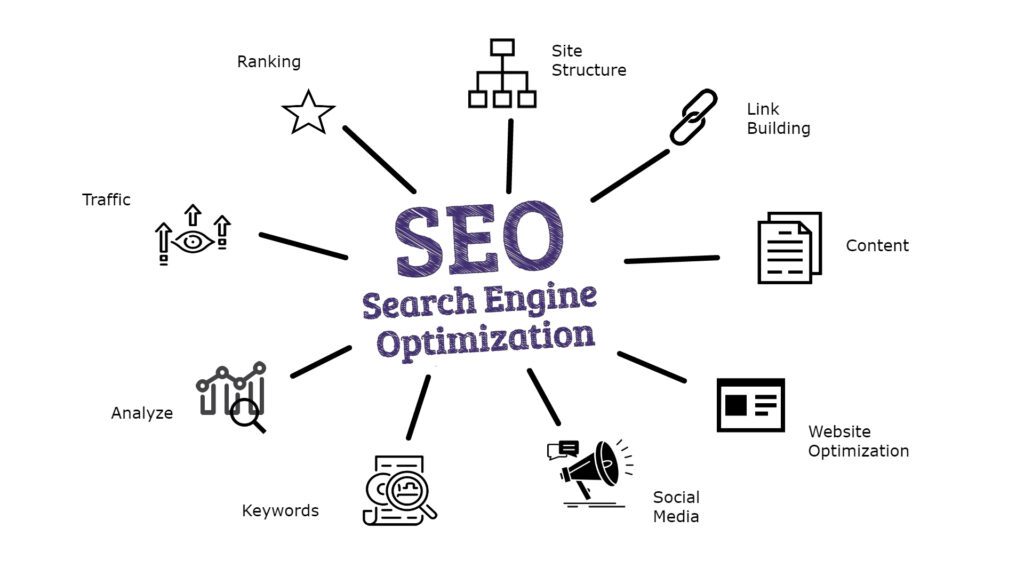
The Ultimate Guide to SEO for Beginners: Boost Your Website’s Visibility
In today’s digital world, having a website isn’t enough; you need to ensure that people can find it. Search Engine Optimization (SEO) is the key to driving organic traffic to your site and improving its visibility on search engines like Google, Bing, and Yahoo. If you’re new to SEO, this guide will walk you through the essentials to help you get started.
What is SEO?
SEO stands for Search Engine Optimization. It is the process of optimizing your website to rank higher on search engine results pages (SERPs) to increase organic (non-paid) traffic. SEO involves various strategies, techniques, and best practices that focus on improving the visibility and usability of your website.
Why is SEO Important?
- Increased Visibility: Higher rankings mean more visibility and clicks.
- Cost-Effective Marketing: SEO provides long-term results without the recurring costs of paid ads.
- Builds Credibility: A well-optimized site appears more credible and trustworthy.
- Improved User Experience: Good SEO practices enhance website usability.
Key Components of SEO
1. On-Page SEO
On-page SEO focuses on optimizing elements within your website to improve rankings. Key aspects include:
- Keyword Research: Identifying relevant search terms your audience uses.
- Title Tags & Meta Descriptions: Compelling and keyword-rich titles and descriptions.
- Content Optimization: High-quality, informative, and keyword-optimized content.
- Internal Linking: Connecting related pages to enhance navigation and authority.
- URL Structure: Clean, readable URLs that include keywords.
2. Off-Page SEO
Off-page SEO refers to activities outside your website that impact its authority and ranking. Important strategies include:
- Backlink Building: Acquiring high-quality links from reputable websites.
- Social Media Marketing: Sharing content to engage users and drive traffic.
- Guest Blogging: Writing for other websites to establish authority.
3. Technical SEO
Technical SEO ensures that your website meets the technical requirements of search engines. Key factors include:
- Website Speed Optimization: Fast-loading pages enhance user experience.
- Mobile-Friendliness: Ensuring your site is responsive and accessible on all devices.
- XML Sitemaps: Helping search engines understand your website structure.
- Secure Website (HTTPS): Enhancing security and trustworthiness.
How to Get Started with SEO

Step 1: Conduct Keyword Research
Use tools like Google Keyword Planner, Ahrefs, or SEMrush to find keywords that are relevant to your niche. Focus on long-tail keywords that have lower competition but higher intent.
Step 2: Optimize Your Content
Create high-quality content that answers user queries and incorporates keywords naturally. Ensure your content is engaging and informative.
Step 3: Improve Site Structure
Ensure your website has a logical structure with easy navigation and clear categories.
Step 4: Build Backlinks
Reach out to authoritative websites in your industry and engage in link-building strategies such as guest posting.
Step 5: Monitor Performance
Use tools like Google Analytics and Google Search Console to track your SEO performance and make necessary improvements.
Common SEO Mistakes to Avoid
- Keyword Stuffing: Overusing keywords can harm readability and rankings.
- Ignoring Mobile Optimization: A non-responsive site can lose valuable traffic.
- Poor Link-Building Practices: Avoid buying links from low-quality sources.
- Neglecting Content Quality: Thin or duplicate content can hurt SEO efforts.
SEO Tools to Help You Succeed

Here are some popular SEO tools to aid your optimization efforts:
- Google Analytics: Track website traffic and user behavior.
- Google Search Console: Monitor site performance in search results.
- Yoast SEO (for WordPress): Optimize on-page SEO for WordPress sites.
- Ahrefs & SEMrush: Conduct competitive analysis and keyword research.
- Moz: Provides insights on domain authority and backlink analysis.
Final Thoughts
SEO is an ongoing process that requires time, effort, and dedication. By implementing the strategies outlined in this guide, you’ll be on your way to boosting your website’s visibility and driving organic traffic. Keep learning, stay updated with SEO trends, and adapt your strategies to achieve long-term success.
Start optimizing today and watch your website soar to new heights!
Conclusion
Mastering SEO might seem overwhelming at first, but by taking it step by step, you’ll gradually improve your website’s visibility and online presence. Focus on providing value to your audience, stay consistent with your efforts, and be patient with the results. Over time, your hard work will pay off with higher rankings, increased traffic, and better engagement.




